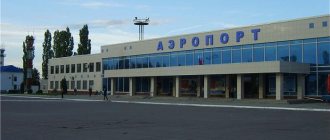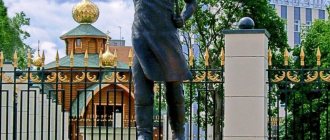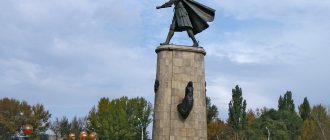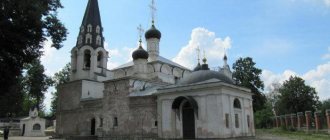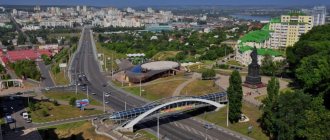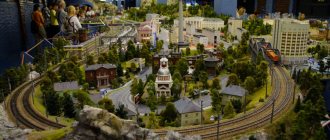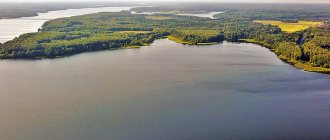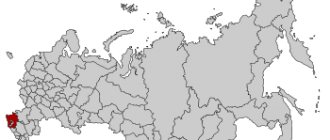Voronezh
Voronezh from above Under Peter I, the city became famous as one of the centers of Russian shipbuilding. During the Great Patriotic War, units of the Soviet army fiercely resisted the enemy and managed to push back the fascist troops far from the borders of Voronezh. In memory of the difficult trials that befell soldiers and civilians, several war memorials have been built here.
In Voronezh you can find many pleasant places for walks. There are good theaters and interesting museums here. The streets, squares and gardens of the city are decorated with monuments erected in honor of famous poets and writers. An expressive monument to a kitten from Lizyukov Street has become a local landmark. The funny hero of the Soviet cartoon announced from the screens back in the 1980s that “there is no better city than Voronezh.”
Streets in Voronezh
Popular places for relaxation are green areas - Brinkmansky Garden, Koltsovsky Square and Scarlet Sails Park, and of course the shore of the Voronezh Reservoir. Tourists and city residents love to visit the Voronezh Oceanarium, as well as get acquainted with beautiful architectural monuments and ensembles of old churches and monasteries.
There are a sufficient number of hotels and mini-hotels to accommodate tourists in Voronezh. According to traveler reviews, due to increased competition in recent years, the quality of guest service in the city has increased. More budget options are offered by hostels and suburban recreation centers. In addition, you can stay in Voronezh by renting an apartment for daily rent.
Video: Voronezh
History of the city of Voronezh
Based on the results of archaeological excavations, it is known that people have inhabited the territory of Voronezh since Paleolithic times. On the right bank of the Voronezh reservoir, many ancient objects and remains of wooden log houses of the 8th-10th centuries were found.
Engraving of Voronezh from the 18th century (Petrovsky Island and the workshop in the foreground)
In 1586, under the leadership of governor Semyon Fedorovich Saburov, the first fortress was erected on the Voronezh River, from which the city later grew. In 1590, it was attacked by the Cherkasy. They completely destroyed the fortress and burned the houses of local residents. However, in just four years, the wooden buildings and fortifications were cut down again.
When the Time of Troubles came in Russia, Voronezh residents opposed the official authorities on the side of False Dmitry I and False Dmitry II. But, despite this, they refused to swear allegiance to the Polish prince Vladislav. In July 1613, the rebels were defeated near Voronezh and fled.
V. Timm, view of Voronezh from the western side, XIX century.
To attract the Don Cossacks to the side of the Russian state, by order of the Tsar, the Voronezh residents supplied weapons, cloth, bread and wine to the Don. In addition, military personnel serving in the city accompanied Russian ambassadors traveling to the territory of the Ottoman Empire.
Local residents had extensive experience in shipbuilding and shipping. For a long time they built plows on which the Russian embassy sailed to the Turkish Sultan. To prepare for the second Azov campaign, a ship, about 1,500 plows, sea boats and rafts were built in Voronezh, which helped capture the previously impregnable fortress. After Azov fell, Peter I created a separate admiralty in Voronezh. Large ships, galleys, as well as small ships and sailing boats were built at local shipyards. From 1696 to 1711, 215 ships were built in Voronezh.
Voronezh in the 19th centuryDuring the 18th and 19th centuries, the city developed as the capital of the Voronezh province. In 1853, the first exhibition of agricultural achievements was held here, and five black soil provinces of the country took part in it.
During the years of Soviet power, Voronezh turned into a major cultural and industrial center. Now it is home to more than a million people.
Voronezh during the USSRSights associated with Peter I
The bronze monument to Peter I is considered one of the symbols of Voronezh. It stands in the city center, on the territory of the green Petrovsky Square. The majestic monument was opened in 1860 and was the fourth monument to the reformer tsar on Russian territory. When the Great Patriotic War was going on, the Germans sent it to be melted down. But in 1956, the historical monument was restored, and it took its rightful place on the old pedestal.
The fact that Voronezh is the cradle of Russian shipbuilding is reminded by a beautiful monument installed on an elevated pedestal in the middle of the Voronezh Reservoir. The tilted sailing frigate is a model of the ship "Mercury", on which Peter I went to recapture the Azov fortress. In the warm season, you can admire the monument from aboard a pleasure boat, and in winter you can reach it on foot on ice.
In Voronezh, only one architectural monument has survived, which witnessed the stay of Peter I in the city. This is the Assumption Admiralty Church - the oldest temple in the city, located on the street. Sophia Petrovskaya, 9. Initially, there was a wooden Church of the Assumption here. By the end of the 17th century, a German craft settlement had formed around it, in which separate palaces were erected for the sovereign and his associates. The new stone Assumption Church was built at the turn of the 17th-18th centuries. All ships and plows cut down at the Voronezh shipyard were blessed in this church.
On Admiralty Square you can see an exact copy of the Russian ship “Goto Predestination” (“God’s Providence”). A large double-decker ship was laid down at the Voronezh shipyard at the end of the 17th century, and its construction and equipment was supervised by Peter I himself. “Goto Predestination” became the first Russian battleship. He began military service in 1710. Tourists can get to the museum ship on Wednesday from 11.00 to 18.00, and from Thursday to Sunday from 10.00 to 18.00.
Museums of Voronezh
If you want to learn more about the history of the city, you should go to the Voronezh Local History Museum, which is located at number 29 on Plekhanovskaya Street. The museum was opened at the end of the 19th century in the building of the City Duma, and by 1941 its collection fund included more than 100 thousand exhibits. Unfortunately, some collections were lost during wartime. In 1959, the museum moved to the building in which it is located today. Today here you can see exhibits telling about the nature of the Voronezh region, archaeological finds and materials about the construction of ships in the late 17th - early 18th centuries.
The Museum of Local Lore has several branches located in different parts of Voronezh. The collections department (Revolution Avenue, 22) displays collections of ceramics, numismatics, glass and folk costume. In the Arsenal building on Stepan Razin Street, 43, you can see exhibitions dedicated to the history of Voronezh during the Great Patriotic War. And in the house on the street. Durova, 2, a branch dedicated to the famous trainer Anatoly Leonidovich Durov has been opened.
The Voronezh Art Museum is named after the famous Russian painter I. N. Kramskoy. The building it occupies is often called the “Voronezh Palace”. The luxuriously decorated baroque mansion was built in the 70s of the 18th century (Revolution Avenue, 18). In the museum you can see rich collections of paintings, graphics, sculpture, antique porcelain and decorative arts. The doors of the art museum are open to visitors from Wednesday to Sunday from 10.00 to 18.00.
The Museum of Forgotten Music is considered one of the interesting attractions of Voronezh. It houses a large collection of musical instruments brought from different parts of the world. Part of the exhibition consists of instruments recreated based on drawings and drawings from ancient books. It’s interesting that during the excursion you can not only examine musical wonders in detail, but also hear how they sound. The museum is located in the building of the House of Culture of Mechanical Engineers (108 January 9th Street).
The city also hosts the Voronezh Regional Literary Museum named after Nikitin (Plekhanovskaya St., 3), the Sports Museum (Revolyutsii Ave., 35), and the H.L.A.M Gallery of Contemporary Art. (Deputatskaya St., 1), Sergei Yesenin Folk Museum (K. Marx St., 112), interactive museum of collectible toys (Platonova St., 3), theater puppet museum (Revolution Ave., 50), as well as an interactive museum for Big and Small “BIM” (Revolution Ave., 48).
Monasteries and temples
Alekseevo-Akatov Monastery is located at the address: st. Liberation of Labor, 1B, not far from the Voronezh-1 railway station. This monastery is considered the oldest in the Black Earth Region. The monastery was founded in 1620, when Russian troops defeated the Lithuanians and Cherkasy. Until the beginning of the 19th century, it was the only men's monastery in the city. In 1931, at the height of the active anti-religious campaign carried out by the Soviet state, the old monastery was closed and its property was lost. For several decades, the architectural monuments stood abandoned and were badly damaged.
The revival of the monastery took place in the 1990s. The territory and buildings were given to the church, and a new convent was created here. Now the monastery buildings have been well restored. They look especially beautiful from the side of the reservoir. Services are held in the monastery every day. However, not only believers are allowed into the monastery, but also everyone who is interested in Russian temple architecture.
40 km from Voronezh, on the territory of the Voronezh Nature Reserve, there is the Tolshevsky Spaso-Preobrazhensky Convent. They get there by bus number 310, which goes from the Central Bus Station, or by train to the Grafskaya station. This monastery appeared in the middle of the 17th century. Its founder is considered to be the hermit Constantine, who lived in the local forests. Because of this, the monastery was originally called the Constantine Hermitage. Like most Russian monasteries, the monastery was closed in the early 1930s and returned to the church in the 1990s.
On the territory of the Pervomaisky Garden, in the center of Voronezh, stands the majestic Annunciation Cathedral, which has the status of a cathedral church of the local diocese. The new cathedral was built in 2009 and received the name of the Annunciation Cathedral of the Mitrofan Monastery, which was lost during the war years. In terms of size, the modern temple is considered one of the largest cathedrals in the country. It rises to 97 m, which corresponds to the height of a 30-story building. Believers come to the Annunciation Cathedral to venerate the relics of Voronezh Bishop Mitrofaniy. The Christian ascetic was known for consecrating new ships of the Russian fleet during the time of Peter I. There is a monument to the bishop near the cathedral.
In Voronezh there are several old churches built in the 18th – early 20th centuries: Ilyinsky Temple (1770), Vvedensky Church (1780), Intercession Cathedral (1841), Assumption Seminary Church or Church of Sergius Serebryansky (1848), Alekseevsky Church (1764) and Kazan Church (1911).
War memorials
In the center of the Northern district of the city, on Moskovsky Avenue, 42, there is one of the most famous memorials in Voronezh dedicated to the events of the Great Patriotic War. In the summer of 1942, fierce battles took place here; dead soldiers and officers were buried in mass graves. The Monument to Glory was opened in 1967. It is a memorial complex with an Eternal Flame and four tombstones near the mass graves. The names of the victims, who have been identified, are engraved on marble slabs.
The large memorial complex “Chizhovsky Bridgehead” is located on the street of the 20th anniversary of October. It was opened in 1975, on the 30th anniversary of the Victory. The memorial was erected near the mass grave where 15 thousand dead soldiers lie. The burial is considered the largest mass burial of the war years in Voronezh. Most of the soldiers lying here are nameless heroes. The names of only 3,545 people are known.
On Matrosova Street you can see the memorial complex “Sandy Log”. At the beginning of the war, the Nazis rapidly advanced and occupied the right bank of Voronezh. In August 1942, a terrible tragedy occurred. In Peschany Log, the Nazis shot 452 unarmed people - civilians, Soviet prisoners of war and wounded soldiers.
Not far from the stele on Victory Square, a monument to a front-line postman was unveiled in 2015 (Revolution Avenue, 25). It is interesting that the prototype of the figure of a soldier with a mail bag was a real person. He became Corporal Ivan Leontyev, who served in Voronezh during the war.
Unusual sights of Voronezh
The oldest residential building in Voronezh is a house that belonged to the wealthy merchant Potap Nikitich Gordenin (Fabrichny Lane, 12). The stone building appeared in the city in 1735, and in the 1820s it was sold to the city authorities. Several families now live here. Unfortunately, the house is in disrepair and there is no rush to restore it.
In Voronezh, the only fire tower has survived (K. Marx St., 32). It rises above the building of the Meshchansky police station, built at the beginning of the 19th century by order of the Russian Emperor Alexander I. It was then that professional firefighting teams began to be created in the country. At the beginning of the 19th century, there were wooden buildings around the fire station, so the watchtower was constantly on duty. The tower was badly damaged during the Great Patriotic War, and after restoration it became half as tall.
On the same street there is a building that Voronezh residents themselves call the “accordion house” (K. Marx St., 94). It was built according to the design of Nikolai Troitsky. The central facade protrudes slightly forward, and it seems that several small houses rise on either side of it. In fact, this is a single building that looks like an accordion. The Voronezh landmark became a tribute to the architectural style of constructivism, which was very fashionable in the 30s of the last century.
One of the main highways of Voronezh is Revolution Avenue. In the park, behind the House of Officers (house no. 32), you can see the “Floating Stone” fountain. He surprises all passersby. It seems that a huge block seems to be “hanging” in the air and is supported solely by the flow of water. The solution to the fountain is simple. It is made of light and durable synthetic material, and the fastening structure is skillfully hidden behind water jets.
Not far away, on Revolution Avenue, 43, stands the most unusual building in Voronezh - the Bristol Hotel. The four-story mansion attracts attention with its rounded shapes and bright design. It appeared in the city at the beginning of the last century and was built in the then popular Art Nouveau style.
At the intersection of Chernyshevsky and Karl Marx streets, east of Koltsovsky Square, you can see another landmark of Voronezh - a picturesque stone bridge, decorated with forged lattice and beautiful lanterns. The bridge is very small - no more than 10 meters. It was erected in 1826, and a huge sum of 5,596 rubles at that time was spent on construction from the city treasury.
If you want to take a little break from the city noise, you should go to the Scarlet Sails pine park, which is located on the shore of the Voronezh reservoir in the area of Arzamasskaya street. There is an unusual monument here - a huge pine cone made of metal. It looks very realistic, and both adults and children love to take pictures near the funny monument.
What you can see in the vicinity of the city
From Voronezh, many travelers go to the Voronezh Biosphere Reserve, which is located on the border of the Voronezh and Lipetsk regions and bears the name of the famous photographer and journalist Vasily Mikhailovich Peskov. The protected area is of great value and has been included in the UNESCO list of biosphere reserves since 1985.
To see another natural attraction - the Don Sahara, it is worth going southeast of the city, to the Petropavlovsky district of the Voronezh region. Don Sahara covers an area of 10 hectares. It is covered with quartz sand and is very similar to a real desert. The sandy “sea” is surrounded by a ring of pine plantations that appeared here in the middle of the last century.
Near Voronezh there is the famous Shipov Forest, the name of which comes from the English word “ship” - ship. During the time of Peter I, the beautiful mountain oak forest was used for making ships and plows. The Russian Tsar was so delighted with the quality of local wood that he called the Voronezh forest “the golden bush of the Russian state.” The main attraction of the Shipov Forest is the Ideal Oak, which is over 170 years old. The powerful tree has gigantic dimensions, and its spreading crown rises more than 40 m.
Tours to the Divnogorye Museum-Reserve are popular among lovers of archaeology, history and nature. People come here to look at the white chalk pillars of the Diva, visit the active Holy Dormition Divnogorsk Monastery, and also visit religious caves and cave complexes.
Not far from Voronezh, in the village of Ramon, there is a picturesque palace complex of the Oldenburgskys. This is a real castle, built in the Old English style. And to the north of the city lies an ancient estate, which from the second half of the 17th century to the beginning of the 20th century belonged to the old noble family of the Venevitinovs. Nowadays it has been turned into a large museum complex.
In recent years, many travelers have been traveling south from Voronezh to the Don village of Kostenki, where more than 60 archaeological sites from the Upper Paleolithic have been excavated. In the museum-reserve created in Kostenki you can learn about how people lived on the banks of the Don more than 20 thousand years ago.
Souvenirs
As traditional souvenirs, items and decorations with the symbols of the city are brought from Voronezh - decorative plates, T-shirts, magnets, mugs and key rings. They are sold at train stations and kiosks. A large selection of souvenirs can be found at Voronezh's Arbat. This is the name of the section of Revolution Avenue, which is located near the House of Officers.
Local nesting dolls, invented about forty years ago by Voronezh master Elena Matveeva, are considered original souvenirs. Matryoshka dolls from Voronezh are shaped like eggs and, unlike ordinary nesting dolls, do not open. They are “dressed” in folk costumes, which were traditionally worn in different areas of the region. Moreover, the details of clothing on the painted toys are reproduced with great accuracy.
Among the “delicious” souvenirs, travelers bring Voronezh balsam, which is made with the addition of herbs and honey. In addition, “Voronezh candies” with views of the city, as well as octagonal boxes with “Koltsov’s Songs” candies, made at the Voronezh confectionery factory, are popular among guests of Voronezh.
Transport
The main public transport network in Voronezh is represented by buses and minibuses. There are also trolleybus lines, but they are few. A local attraction is the so-called “people’s” buses, in which you can travel around the city for free. They are easily identified by the letter “H” in the route name.
Voronezh residents have long loved bicycles, and tourists on two-wheeled vehicles are respected by pedestrians and drivers. The city has a developed cycling tradition. Mass bicycle rides and bicycle rides to historical sights are popular in Voronezh. You can rent bicycles in hostels, hotels and special rental points.
Some travelers prefer to rent cars. This is convenient for independent travel through city streets and attractions in the vicinity of Voronezh. There are many places in the city where you can rent cars. These include small private rental points and representative offices of international rental companies.
For those who drive, it is worth planning travel routes depending on the time of day and day of the week. As in any large Russian city, in Voronezh there are traditional traffic jams in the center during rush hours, and on weekends there is a congestion of cars leaving the city.
Interesting Facts
- The first Russian city of Voronezh appeared in the 9th century in the Chernigov region. Its name comes from the nickname Raven, so the name of the settlement was also pronounced with the emphasis on the first syllable. The second Voronezh was built, thanks to Chernigov settlers, near Ryazan. Mentions of him can be found in Russian chronicles for 1177. Then the emphasis in the name moved to the second syllable, and this is how the place and the river were called. And in 1586, after the construction of a fortress here, the name “Voronezh” was assigned to it.
- In Voronezh there is Peter Sazonov Street, but such a person has never existed. Previously, this place was the location of a street named after the revolutionary Pyotr Alekseev. It was crossed by another street, which received its name in memory of the Socialist Revolutionary terrorist Yegor Sazonov, at whose hands the Tsarist Minister of Internal Affairs V.K. Pleve died. When the city was being reconstructed, the names of the two streets were combined. Thus was born a new street, named in honor of an unknown person, Peter Sazonov.
- There is an entire district in the city named after an enterprise that never existed - VAI or Voronezh Aviation Institute. It was planned to be created before the start of the Great Patriotic War, but these plans were not destined to come true.
- Since 2003, near the Voronezh cinema "Mir" there has been a monument to the hero of the popular cartoon - the kitten from Lizyukova Street. And in Voronezh there is a monument to the dog, the hero of Gabriel Troepolsky’s story “White Bim Black Ear”.
- In June 1941, the Voronezh plant named after the Comintern began producing Katyusha launchers.
- In 1968, the Voronezh Aviation Plant put into serial production the supersonic transport aircraft TU-144, whose speed was more than twice the speed of sound.
Special offers on Voronezh hotels
Booking.com
How to get there
Voronezh is 534 km away from Moscow. Chertovitskoye Airport is located 13 km north of the center of Voronezh and receives flights from many cities in Russia and from abroad. The flight from Moscow to Voronezh lasts 1-1.5 hours, and from St. Petersburg – 2-2.5 hours. You can get from the airport to Voronezh by buses, minibuses and taxis.
The M4 Don federal highway passes by Voronezh, so it’s easy to come here by car. The journey from Moscow takes about 6 hours.
Regular buses "Moscow - Voronezh" run from the metro stations "Paveletskaya", "Shchelkovskaya", "Krasnogvardeyskaya" and "Varshavskaya". Buses reach Voronezh in 6-9 hours. You can travel from St. Petersburg to Voronezh in 20 hours. All intercity bus services are accepted by the South-Western bus station, Levoberezhny and Central bus stations.
There are two railway stations in the city. Trains travel from Moscow to Voronezh in 7-10 hours, and from St. Petersburg in 16-20 hours.
Calendar of low prices for air tickets
First written mentions
The history of the city of Voronezh, according to some historians, begins long before 1177. This is evidenced by the chronicle, which mentions the battle of the Vladimir and Ryazan princes, which ended with the escape of Yaropolk of Ryazan to the village of Voronozh. In addition, in the memoirs of the outstanding European medieval traveler monk Julian, written in 1235, there is a record that the third part of Batu Khan’s army stopped opposite the Don River near the castle, which belonged to the “principality of the Russians.” Researchers whose subject of study is the history of the city of Voronezh believe that this is exactly what we are talking about. Another chronicle record about this settlement dates back to 1284. There, when describing the reprisal of the Tatars against the inhabitants of the Kursk Principality, the “Voronezh forests” are mentioned.
At the end of the 17th century
Population statistics and the history of the city of Voronezh began to be more or less accurately tracked and documented from the second half of the 17th century. In particular, it is known that in 1677 there were more than 300 clerks, townspeople and peasant households, as well as 15 churches, of which 3 were monasteries.
In 1682, the Voronezh diocese was formed, the first head of which was Bishop Mitrofan. In addition, it is known that in 1683 the strength of the Voronezh regiment was 1099 soldiers, of which 580 were from the city itself and from adjacent villages.
Under Peter the Great
In 1696-1725, Voronezh occupied lands on the right bank of the river of the same name in the area of modern Admiralteyskaya Square. In 1696-1722, Peter the Great visited the city several times, spending a total of more than 500 days there. During this period, Voronezh at times became the de facto capital of the Russian state. In particular, it was there that the most important alliance treaty with Denmark was signed in 1699.
In general, the history of the city of Voronezh could have been completely different if not for Peter the Great, who decided to begin building a military fleet there. It was built for operations in the Black and Azov Seas against Turkey. The work was so large-scale that even new cities appeared near the shipyards - Pavlovsk and Tavrov. In total, approximately 200 galleys and multi-gun ships were built on them. The fleet built near Voronezh helped Russia capture Azov, a powerful Turkish fortress located where the Don flows into the Sea of Azov.
In 1711, the city received provincial status and became the administrative center of the territorially quite extensive Azov province. After 14 years, it was renamed Voronezh, however, in 1779, during administrative reforms, its size underwent a sharp reduction.
Base
The description and history of the city of Voronezh are of great interest to tourists who want to visit it. However, there is still no consensus on how long Voronezh has existed. The history of the city officially dates back to 1585. The basis is the entry in the Discharge Order, according to which “the unsubscription of the Ryazan boarding orders ... to the new city of Voronezh” must be made. Around the same time, construction of a fortress began there. The management of its construction was entrusted to the first Voronezh governor, Semyon Saburov. Peasants from the cities of Pereslavl Ryazan, Dankov, Ryazhsk, as well as carpenters, archers and other service people were sent to build the new city.
During the period of revolutionary events and during the Civil War
In the fall of 1905, mass unrest began in Voronezh, ending with the Black Hundred pogrom. In the same year, a mutiny arose in the disciplinary battalion stationed there, which was soon suppressed. Later, in December 1905, a political strike took place in the city.
No less violent events began to occur in Voronezh after it became known there about the overthrow of the Provisional Government in Petrograd. In particular, already on October 30, 1917 (old style), Soviet power was established there. In addition, the city of Voronezh (the history briefly up to the 20th century is presented above) became one of the first cities in which a special detachment of the Red Army was formed.
Events of the early 17th century
The economy of medieval Voronezh was also undermined by the events that took place during the Time of Troubles. The fact is that famine caused by a poor grain harvest in the central regions of the Moscow State forced their inhabitants to flee to the south. As a result, several thousand people in Voronezh found themselves homeless and without means of subsistence. This led to a shortage of food in the city, and the “last straw in the cup of patience” was the so-called tithe tax, which was introduced by Boris Godunov. As a result, the residents supported False Dmitry the First, and then refused to submit to Shuisky. Some time later, in 1610, the residents of Voronezh received False Dmitry II, who was preparing a refuge for himself in Voronezh, collecting food and weapons there. However, he was unable to use them, as he was killed on December 22.
Before Peter's era
The further history of the city (Voronezh, year of foundation - 1585) was marked by numerous uprisings. So, in 1648, the townspeople unsuccessfully tried to get rid of the power of the governor Vasily Gryazny, and in 1670-1671 they took an active part in the Peasant War, led by Stepan Razin. This was facilitated by the fact that the ataman’s uncle lived in the city. However, local governors managed to prevent a rebellion in the city, and the arriving tsarist troops under the leadership of governor G. Romanovsky were able to finally suppress the rebellion around Voronezh.
In the 16th century
In 1590, Voronezh (the history of the city in previous centuries is rather poorly known) was destroyed by the Kanev Circassians. Historians believe that the reason for its rapid restoration is the fact that the settlement was located on a busy trade route, at the confluence of the Voronezh and Don rivers. It was this reason that contributed to the further development of the city.
In the middle of the 16th century, trade in Voronezh reached large proportions, but soon in the south of Rus' the Ostrogozh Circassians began to build new cities, endowed with the right of duty-free trade and shredding. Voronezh was deprived of such privileges, so its economic prosperity was under serious threat.
In the first half of the 19th century
At the beginning of the 19th century, the first gymnasiums and public schools were opened in Voronezh, and in 1802 the first professional theater began operating there. An interesting event was also marked in 1804, when candle lighting was introduced on 9 main streets. The peaceful life of Voronezh residents was disrupted by Napoleon's invasion. It is known that during the Patriotic War of 1812 the city sent 10 militia regiments to the front.
The first half of the 19th century remained in the memory of contemporaries thanks to the miracles associated with the incorruptible relics of St. Mitrofan, which are mentioned in the history of the city (Voronezh). There were reasons to consider the Metropolitan a saint during his lifetime, but it was in 1830 that a huge number of believers arrived in Voronezh, wanting to ask him for intercession. The influx of a large number of believers gave impetus to the development of the cholera epidemic.
Every day 300-400 people died from this disease in the city. Thanks to the efforts of Governor Begichev, cholera was defeated, and a special hospital with 200 beds was built in Voronezh.
The history of the city (Voronezh can take a very long time to describe in detail) also contains mention of the arrival of Emperor Nicholas I there. The monarch visited him to participate in the solemn ceremony of opening the relics of St. Mitrofan.
